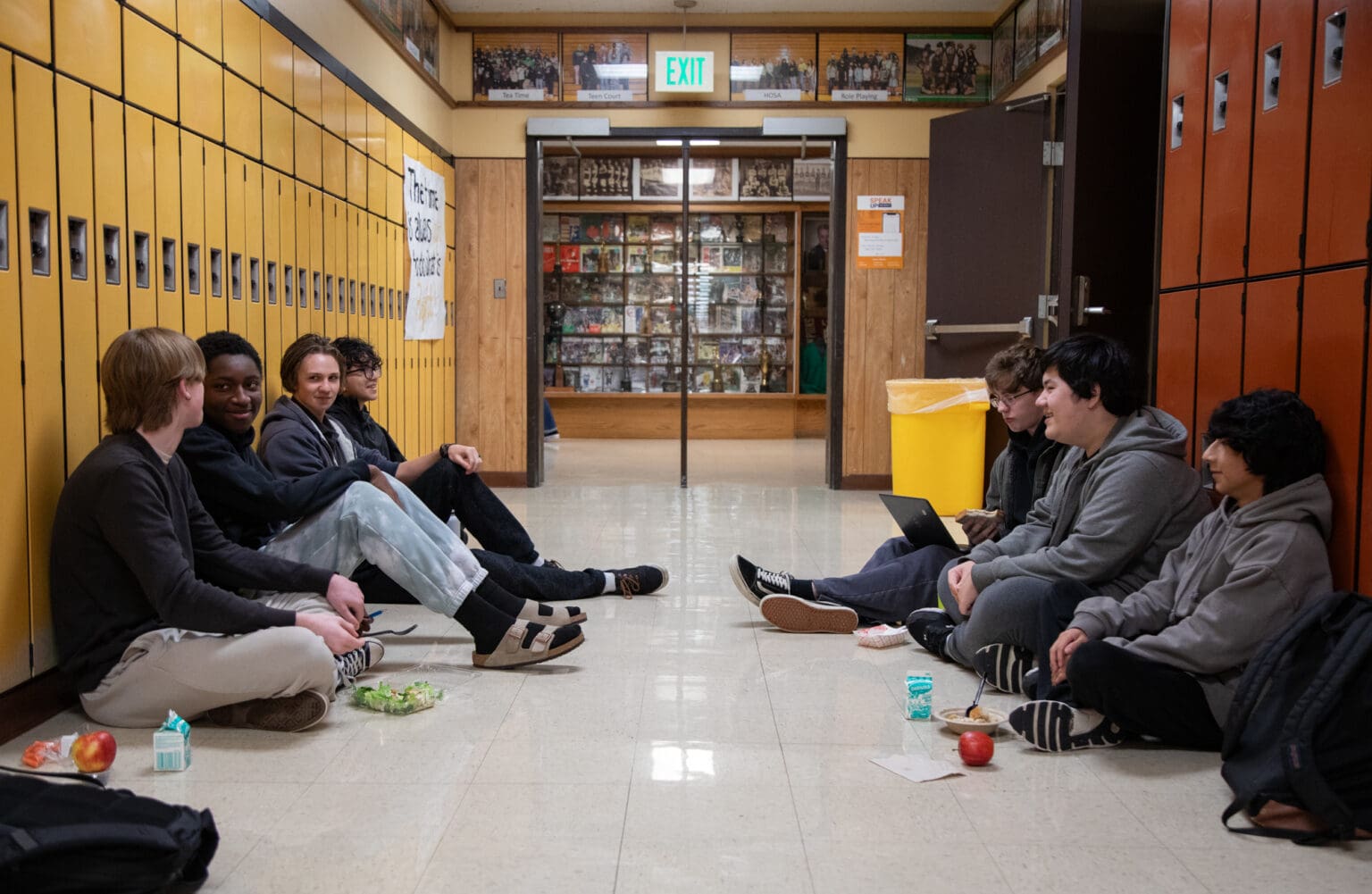At Lynden High School, 43 years of wear and tear are showing.
Yellow power cords snake through classrooms, between aging tables and creaky chairs, to provide enough power for students’ laptops — an issue not considered when the school was built in 1980.
Old plumbing and electrical systems are failing, requiring ongoing replacement of pipes, outlets and fixtures, according to the district.
The cafeteria isn’t large enough to fit all students, even with lunch scheduled in two shifts. Many spend their lunch hours sitting in the hallways, or outside if the weather permits.
Just six bathrooms — two women’s, two men’s and two single-occupancy — serve hundreds of students. Nine portable classrooms, plus 37 permanent classrooms, can’t house growing numbers of students.
Security is an ongoing concern, with campus buildings having more than 70 points of entry.
“The fact is that there is all this pride and energy [for Lynden] but not the facility to support it,” said Michelle McIlvoy, a parent and member of Citizens for Lynden Schools Committee.
Lynden voters on Feb. 13 will be asked to approve $157.5 million in bonds to give Lynden’s next generation a modern high school, with funds set aside for upgrades at other district facilities. The high school is projected to cost $129.7 million.

The community’s steady growth is reflected in its schools, which are bursting at the seams.
The high school, built in 1980, was designed for 740 students. Today, just under 900 students traverse the halls, and the district anticipates 925 students by the 2029-30 school year – and more than 1,000 by 2039, according to its Capital Facilities Plan.
The bonds would also pay for the addition of permanent classrooms and updated heating and ventilation systems at Isom Elementary and Bernice Vossbeck Elementary; and the installation of HVAC systems on the second floor at Fisher Elementary and Lynden Middle School.
“Lynden is becoming a more attractive community to be a part of,” high school Principal Ian Freeman said. “Our families are super supportive. People enjoy the amenities that our community has. We have a great downtown, restaurants. We have retail. We have great parks. They feel safe. It’s a nice place to raise kids, so people are going to move here.”
The proposed new high school’s 62 classrooms would house 1,240 students.
If approved, a tax rate of $1.53 per $1,000 of assessed value would be applied to Lynden property taxes. Residents with a $500,000 home would pay $765 annually. The state constitution requires a 60% “supermajority” vote for the bond measure.
The bond will run alongside an educational programs and operations levy, a renewal of the prior levy that funds 14% of district operations, including but not limited to extracurricular programs, security, nursing staff, para-educators, electives and special education. Levy elections require a simple majority.
The campus’s ‘fatal design flaw’
Current classrooms, Freeman said, lack flexibility and the ability to support modern learning.
Classrooms are sequestered into pods with direct outside access — a design referred to colloquially as “California style.”

“When this building was designed, it was designed for desks in a row for classes,” Freeman said. “The need for flexibility is totally clear. Businesses recognize it, post-secondary institutions, colleges and community colleges — they all recognize it.”
Freeman and superintendent David VanderYacht said teachers and students would benefit from flexible, shared spaces where students can collaborate in small groups — a common design addition in new schools like Sunnyland Elementary.
Lynden High currently only has flex spaces when the sun shines, and the students can sit in the courtyard to discuss a project or assignment.
The bond funding would also upgrade the Lions’ athletic field to artificial turf, expand the bleachers and update the beloved Jake Maberry Gymnasium. A new campus would include a performing arts center and a large career and technical education space.

Safety of the campus is another concern for teachers, administrators and students with dozens of entry doors from the outside going indoors.
“I think there’s a responsibility that we provide a safe, secure environment,” VanderYacht said.
VanderYacht said an enclosed building that easily restricts access from the exterior would increase security.
He said the design would be similar to the new Ferndale High School campus, complete with open interior spaces to promote collaboration and community.
“I think the wellness of our young people requires our ability to create connection,” VanderYacht said. “I think this [building] has a fatal design flaw for supporting that. If you’re a young person that wants to separate and disengage from others, you’re able to do that here.”
Timing of the bond: Why now?
With inflation and rising costs, many have questioned why the district is running a bond now.
But the conversation in the school district is not “if” a new high school is needed, but “when?”
Caleb Hazel, a Lynden parent of three, said when he assumed his role on the Bond Planning Task Force, he was leaning toward waiting on running the bond. Quickly, however, he saw the urgency to get students in a new campus.
“It was never a matter of ‘When should we do this?'” he said, “It was, ‘Why didn’t we do this earlier?'”

In 2015, after four attempts, Lynden passed a bond to replace Lynden Middle School. In the four years after the first attempt to pass a bond in 2011, the cost to the community increased by $13 million.
VanderYacht said the district’s goal is avoid costing the community more money by delaying.
“If we determine that the need is there, then the most fiscally responsible thing to do, is to do the best job we can to make Plan A the best plan and get it passed the first try,” he said.
If passed, VanderYacht said the district would organize a Bond Oversight Committee to keep the community informed on spending and progress, similar to Ferndale School District.




